
There are many people who have jobs that require standing and working on their feet. Foot pain is a common ailment among people who are in this category and it can be reduced or diminished when the proper footwear is worn. It is beneficial to wear a shoe with a small heel and weakness and soreness can be reduced when work shoes have proper arch support. It is important that shoes fit correctly as this may prevent poor circulation and blisters from developing. Some people choose to wear compression socks, which can be helpful in reducing blood flow to the feet, and redirecting it toward the heart. When the workday is finished, the feet will feel better when they are soaked in cold water followed by massaging them. This is beneficial in reducing inflammation and swelling that can happen during the work day. If you would like additional information about how your feet can feel better at the end of the day, please speak with a podiatrist who can offer you effective foot care tips.
While working on the feet, it is important to take the proper care of them. For more information about working on your feet, contact Dr. Richard DiMario from Maine. Our doctor will treat your foot and ankle needs.
Working on Your Feet
Standing on your feet for long periods of time can cause stress and pain in your feet. Your whole body may experience change in terms of posture, back pain, bunions, callouses and or plantar warts. There are ways to avoid these conditions with proper foot care, smart choices and correct posture.
Positive Changes
Negative heeled shoe – Choosing this shoe type places the heel slightly lower than the ball of the foot. These are great for overall foot health. Find shoes that fit you correctly.
Go barefoot – Our feet were not designed to be enclosed for all hours of the day. Try to periodically expose your feet to air.
Eliminate Pain
Foot Exercises – Performing simple exercises, incorporating yoga and doing stretches are beneficial. This will allow increased blood flow to the area and muscles of the foot.
Achilles tendon – Stretching the foot out flat on the floor will relax the calf muscles and tendon. These exercises can be performed almost anywhere. Make sure you add these exercises to your daily regimen.
With a little bit of this information and knowing more about foot health, you will notice changes. Foot stretches and proper footwear will help with pain and prevent further issues.
If you have any questions please feel free to contact our office located in York, ME . We offer the newest diagnostic and treatment technologies for all your foot and ankle needs.
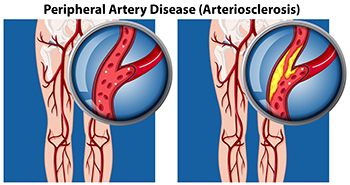
About 6.5 million people in the United States over the age of 40 have peripheral artery disease (PAD). It is a blockage in the arteries that supply blood to the extremities, but the condition is more common in the feet and lower limbs. Risk factors for peripheral artery disease include smoking, high blood pressure, diabetes, atherosclerosis, and high cholesterol. People over 60 are at further risk. The most common symptom of PAD is pain in the legs while active, but that subsides after resting. Sores in the legs or feet that don’t heal and cold or numb toes are other symptoms as well. If you believe you may have PAD, please consult a podiatrist for an examination and testing.
Peripheral artery disease can pose a serious risk to your health. It can increase the risk of stroke and heart attack. If you have symptoms of peripheral artery disease, consult with Dr. Richard DiMario from Maine. Our doctor will assess your condition and provide you with quality foot and ankle treatment.
Peripheral artery disease (PAD) is when arteries are constricted due to plaque (fatty deposits) build-up. This results in less blood flow to the legs and other extremities. The main cause of PAD is atherosclerosis, in which plaque builds up in the arteries.
Symptoms
Symptoms of PAD include:
It is important to note that a majority of individuals never show any symptoms of PAD.
Diagnosis
While PAD occurs in the legs and arteries, Podiatrists can diagnose PAD. Podiatrists utilize a test called an ankle-brachial index (ABI). An ABI test compares blood pressure in your arm to you ankle to see if any abnormality occurs. Ultrasound and imaging devices may also be used.
Treatment
Fortunately, lifestyle changes such as maintaining a healthy diet, exercising, managing cholesterol and blood sugar levels, and quitting smoking, can all treat PAD. Medications that prevent clots from occurring can be prescribed. Finally, in some cases, surgery may be recommended.
If you have any questions, please feel free to contact our office located in York, ME . We offer the newest diagnostic and treatment technologies for all your foot care needs.
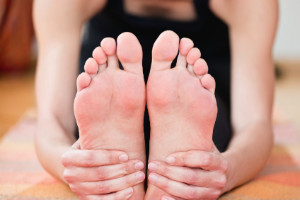
The feet carry the weight of the body so it is important to take proper care of them. One of the best things you can do for your feet is stretch them frequently. This helps maintain flexibility and range of motion. A stretch that can help the plantar fascia is performed by practicing a foot roll. This is done by placing your foot on top of a golf ball and rolling it back and forth. People who stand for the majority of the day also find this to be an effective foot stretch. The toes can become stronger when toe stretches are done, and this can positively affect the overall foot. Additionally, a towel lift is good for the toes and middle of the foot. This is done by placing a towel on the floor while sitting in a chair and lifting the towel with the toes. The heels can benefit from standing on a step and lowering the heels one at a time until a gentle stretch is felt. If you would like more information about the benefits of stretching the feet and additional stretches to practice, please consult with a podiatrist.
Why Stretching Is Important for Your Feet
Stretching the feet is a great way to prevent injuries. If you have any concerns with your feet consult with Dr. Richard DiMario from Maine. Our doctor will assess your condition and provide you with quality foot and ankle treatment.
Stretching the Feet
Stretching the muscles in the foot is an important part in any physical activity. Feet that are tight can lead to less flexibility and make you more prone to injury. One of the most common forms of foot pain, plantar fasciitis, can be stretched out to help ease the pain. Stretching can not only ease pain from plantar fasciitis but also prevent it as well. However, it is important to see a podiatrist first to determine if stretching is right for you. Podiatrists can also recommend other ways to stretch your feet. Once you know whether stretching is right for you, here are some excellent stretches you can do.
It is best to go easy when first stretching your foot and work your way up. If your foot starts hurting, stop exercising to ice and rest the foot. It is advised that you then see a podiatrist for help.
If you have any questions, please feel free to contact our office located in York, ME . We offer the newest diagnostic and treatment technologies for all your foot care needs.
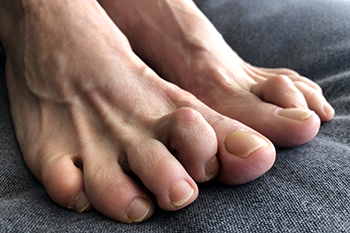
Wearing shoes that fit your feet and are comfortable can avoid many problems. Hammertoes are one such problem that can develop from wearing shoes that have pointy toes, are too tight, or that otherwise put pressure on your toes. The second and third toes are the most likely toes to be affected. Hammertoes get their name because the middle joint of the toe gets stuck in an upward bent position, creating a deformity resembling a hammer. This deformity is the result of an imbalance in the muscles and ligaments around the toe joint caused by either improper footwear or other factors such as genetics, overly high arches, bunions, injuries, and certain medical conditions. Shoes with uppers that are soft and flexible, as well as those that provide arch support and ample room in the toe box, can help prevent hammertoes. It is important to treat hammertoes early, before they become rigid. A podiatrist can treat your hammertoe and may also help you select footwear that will help prevent hammertoes from occurring in the future.
Hammertoe
Hammertoes can be a painful condition to live with. For more information, contact Dr. Richard DiMario from Maine. Our doctor will answer any of your foot- and ankle-related questions.
Hammertoe is a foot deformity that affects the joints of the second, third, fourth, or fifth toes of your feet. It is a painful foot condition in which these toes curl and arch up, which can often lead to pain when wearing footwear.
Symptoms
Causes
Genetics – People who are genetically predisposed to hammertoe are often more susceptible
Arthritis – Because arthritis affects the joints in your toes, further deformities stemming from arthritis can occur
Trauma – Direct trauma to the toes could potentially lead to hammertoe
Ill-fitting shoes – Undue pressure on the front of the toes from ill-fitting shoes can potentially lead to the development of hammertoe
Treatment
Orthotics – Custom made inserts can be used to help relieve pressure placed on the toes and therefore relieve some of the pain associated with it
Medications – Oral medications such as anti-inflammatories or NSAIDs could be used to treat the pain and inflammation hammertoes causes. Injections of corticosteroids are also sometimes used
Surgery – In more severe cases where the hammertoes have become more rigid, foot surgery is a potential option
If you have any questions please contact our office located in York, ME . We offer the newest diagnostic and treatment technologies for all your foot and ankle needs.
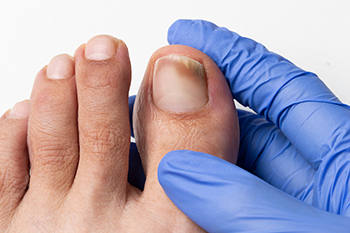
Toenail fungus is a noticeable foot condition. A toenail that is dark and thick can be caused by a fungus that is known as dermatophytes. The nail can change shape, and the color may differ as a result of the area which is affected underneath the nail. Many times, the nail on the big toe is the first to start developing toenail fungus, and in severe cases, it may travel to other nails. There may be existing medical conditions that can lead to toenail fungus. These can include diabetes, problems with circulation, or a weakened immune system. If this condition is not treated promptly, the nails may begin to crumble, and the fungus may grow under the nail, and possibly ooze. Effective treatment may take months to completely heal the fungus, and it is important to stay consistent with applying creams, and taking medication. A podiatrist can properly diagnose and treat this condition, and it is suggested that you schedule an appointment as soon as possible so the proper treatment can begin.
For more information about treatment, contact Dr. Richard DiMario of Maine. Our doctor can provide the care you need to keep you pain-free and on your feet.
Toenail Fungus Treatment
Toenail fungus is a condition that affects many people and can be especially hard to get rid of. Fortunately, there are several methods to go about treating and avoiding it.
Antifungals & Deterrence
Oral antifungal medicine has been shown to be effective in many cases. It is important to consult with a podiatrist to determine the proper regiment for you, or potentially explore other options.
Applying foot powder on the feet and shoes helps keep the feet free of moisture and sweat.
Sandals or open toed shoes – Wearing these will allow air movement and help keep feet dry. They also expose your feet to light, which fungus cannot tolerate. Socks with moisture wicking material also help as well.
If you have any questions please feel free to contact our office located in York, ME . We offer the newest diagnostic tools and technology to treat your foot and ankle needs.

As a parent or guardian, you may wonder if your young child’s stance or gait is normal as they learn how to stand and walk. As your child grows, most issues will work themselves out, but there are some things you should monitor. When babies are born, they do not have arches, which is known as having flat feet. Typically, by the time a child is 6 years old, their arch is developed and visible when they stand. Around the age of 4, many children will have a small gap between their ankles when standing with their knees together (knock knees) which should go away by the age of 6 or 7 when their legs straighten out fully. If the gap is between both their knees and ankles, this is known as bow legs. This condition is commonly present in children less than 18 months old. Some young children walk on their tiptoes (tiptoe walking) until approximately 3 years of age, and thereafter will usually adopt the normal heel-to-toe walking pattern. Feet that turn in (in-toeing) or turn out (out-toeing) will usually start pointing straight by themselves when the child is roughly 8 years old. Regular check-ups with a podiatrist will help ensure that your child’s feet are developing normally. Also, if the issues mentioned here do not go away on their own, or you have any concerns about your child’s foot or ankle health, have your child examined by a podiatrist right away.
The health of a child’s feet is vital to their overall well-being. If you have any questions regarding foot health, contact Dr. Richard DiMario of Maine. Our doctor can provide the care you need to keep you pain-free and on your feet.
Tips for Keeping Children's Feet Healthy
If you have any questions, please feel free to contact our office located in York, ME . We offer the newest diagnostic and treatment technologies for all your foot care needs.

Many people who enjoy running can experience a small amount of normal discomfort. This may be from strengthening the heart and leg muscles. Additionally, there are people who have persistent pain, and this is something that requires immediate attention. An improper running form or increasing distance and intensity too soon could result in injury. A common foot injury that affects the heel is known as plantar fasciitis, and this can cause difficulty in walking. There are simple methods that can help prevent running injuries. These methods consist of wearing shoes that fit correctly, in addition to avoiding running on uneven surfaces. Many runners can experience a stress fracture which is a hairline fracture. This type of injury is often ignored and can lead to severe pain and discomfort. This condition may be prevented by properly warming up and cooling down before running. An ankle sprain generally requires running to be stopped temporarily so an effective healing process can take place. If you would like more information about how to prevent running injuries, please confer with a podiatrist.
Exercising your feet regularly with the proper foot wear is a great way to prevent injuries. If you have any concerns about your feet, contact Dr. Richard DiMario of Maine. Our doctor will treat your foot and ankle needs.
How to Prevent Running Injuries
Many common running injuries are caused by overuse and overtraining. When the back of the kneecap starts wearing out and starts causing pain in your knee, this is commonly referred to as runner’s knee. Runner’s knee is a decrease in strength in your quadriceps and can occur if you’re not wearing properly fitted or supporting shoes. To prevent runner’s knee, focusing on hip strengthening is a good idea, as well as strengthening your quads to keep the kneecaps aligned.
What Are Some Causes of Running Injuries?
- One cause of a common running injury is called iliotibial band syndrome.
- Plantar fasciitis is also another common injury.
- Stress fractures can occur from overtraining, lack of calcium, or even your running style.
Best Ways to Prevent Running Injuries
- Wear footwear that fits properly and suits your running needs.
- Running shoes are the only protective gear that runners have to safeguard them from injury.
- Make a training schedule. Adding strengthening exercises as well as regular stretching can help keep you strong and limber and can lessen the possibility of injuries.
- Stretching keeps muscles limber; this will help you gain better flexibility.
If you have any questions please feel free to contact our office located in York, ME . We offer the newest diagnostic and treatment technologies for all your foot and ankle needs.
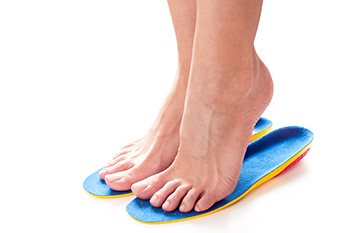 There are many people who choose to wear orthotics. These are inserts that are constructed of different materials and can consist of rigid, flexible, or plastic, and are used to treat various foot conditions. They can help to improve foot structure, and patients who have flat feet may benefit by wearing orthotics. Research has indicated orthotics may lift the natural arch and can possibly help to prevent invasive surgery. Some orthotics are made with added cushioning in the heel and ball of the foot, and this can help with pain and discomfort from plantar fasciitis. Some orthotics are full insoles, and will fill the entire shoe. Additionally, there are small heel orthotics that are made, which fit into the back cup of the shoe. Some patients will use an ankle-foot orthotic, and this extends from the calf to the heel. Orthotics can be a successful option to treat different foot conditions, and it is strongly suggested that you consult with a podiatrist who can determine if this is the best option for you.
There are many people who choose to wear orthotics. These are inserts that are constructed of different materials and can consist of rigid, flexible, or plastic, and are used to treat various foot conditions. They can help to improve foot structure, and patients who have flat feet may benefit by wearing orthotics. Research has indicated orthotics may lift the natural arch and can possibly help to prevent invasive surgery. Some orthotics are made with added cushioning in the heel and ball of the foot, and this can help with pain and discomfort from plantar fasciitis. Some orthotics are full insoles, and will fill the entire shoe. Additionally, there are small heel orthotics that are made, which fit into the back cup of the shoe. Some patients will use an ankle-foot orthotic, and this extends from the calf to the heel. Orthotics can be a successful option to treat different foot conditions, and it is strongly suggested that you consult with a podiatrist who can determine if this is the best option for you.
If you are having discomfort in your feet and would like to try orthotics, contact Dr. Richard DiMario from Maine. Our doctor can provide the care you need to keep you pain-free and on your feet.
What Are Orthotics?
Orthotics are inserts you can place into your shoes to help with a variety of foot problems such as flat feet or foot pain. Orthotics provide relief and comfort for minor foot and heel pain but can’t correct serious biomechanical problems in your feet.
Over-the-Counter Inserts
Orthotics come in a wide variety of over-the-counter inserts that are used to treat foot pain, heel pain, and minor problems. For example, arch supports can be inserted into your shoes to help correct overarched or flat feet, while gel insoles are often used because they provide comfort and relief from foot and heel pain by alleviating pressure.
Prescription Orthotics
If over-the-counter inserts don’t work for you or if you have a more severe foot concern, it is possible to have your podiatrist prescribe custom orthotics. These high-quality inserts are designed to treat problems such as abnormal motion, plantar fasciitis, and severe forms of heel pain. They can even be used to help patients suffering from diabetes by treating foot ulcers and painful calluses and are usually molded to your feet individually, which allows them to provide full support and comfort.
If you are experiencing minor to severe foot or heel pain, it’s recommended to speak with your podiatrist about the possibilities of using orthotics. A podiatrist can determine which type of orthotic is right for you and allow you to take the first steps towards being pain-free.
If you have any questions please contact our office located in York, ME . We offer the newest diagnostic and treatment technologies for all your foot and ankle needs.